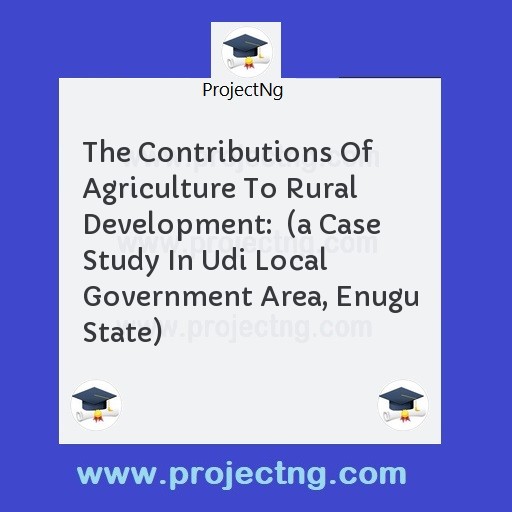The Contributions Of Agriculture To Rural Development: (a Case Study In Udi Local Government Area, Enugu State)
Office Technology & Management Project Topics
Get the Complete Project Materials Now! »
THE CONTRIBUTIONS OF AGRICULTURE TO RURAL DEVELOPMENT: (A CASE STUDY IN UDI LOCAL GOVERNMENT AREA, ENUGU STATE)
ABSTRACT
For the purpose of this research work, an opinion survey was made using oral interview and author - constructed questionnaire to examine “the contributions of agriculture to rural development” using Udi Local Government Area of Enugu as a case study.
The researchers relied on data collected from seventy-five (75) respondents who were agricultural concerned persons.
To guide the research, the above opinions were gathered and analysed/interpreted, analysis of data revealed agriculture is the main stay of the rural dwellers, that proper awareness has not been created about agriculture by those concerned and that these rural dwellers are aware of the contributions of agriculture to rural development.
However further analysis of data received courtesy opinions of respondents revealed that the government has not done so much as it supposed for agricultural development in rural areas, more to this that most of the factors hindering the effective advancement of agriculture are not natural but man-made, hence could be solved.
However, it is suggested that further and more indepth research on this study should be done as to as to ascertain factors impending or militating against the contributions of agriculture to rural development, also on ways these contributions could be fully utilized to effectively develop rural areas.
TABLE OF CONTENTS
Title page
Approval page
Dedication
Acknowledgement
Abstract
Table of content
CHAPTER ONE:
1.0 Introduction
1.1 Background of the study
1.2 Statement of problems
1.3 Objectives of the study
1.4 Delimitation of the study
1.5 Significance of the study
1.6 Research Questions
1.7 Definition of terms
CHAPTER TWO:
2.1 Literature Review
2.2 The contributions of agriculture
2.3 References
CHAPTER THREE:
3.0 Research Methodology
3.1 Research Design
3.2 Area of study
3.3 Population of study
3.4 Sample and Sampling procedure
3.5 Instrument validity and reliability
3.6 Method of data collection
3.7 Method of data analysis
CHAPTER FOUR:
4.0 Presentation, analysis and interpretation of data
4.1 Preliminary question
CHAPTER FIVE:
5.0 Findings, Conclusion and Recommendation, Summary of findings
5.1 Conclusion
5.2 Recommendation
5.3 Limitations
5.4 Areas for further study
Bibliography
CHAPTER ONE
INTRODUCTION
1.1 BACKGROUND OF THE STUDY:
Agriculture according to Anyanwu, A. C. (1975) can be defined as “a cultivation of the land for the purpose of producing food for man and animals and also fibre or raw materials for our industries”. It also includes the processing and marketing of crops.
Another definition from V. O. Akinyosoye O. (1976) states that agriculture is concerned basically with the husbandry of crops and animals for food and other purpose.
Agriculture has been the main stay of man right from the earliest times. It is the oldest occupation and the entire world depends mostly on it for food requirements. In the olden days, man practiced crude method of farming which involved local tool such as stones, sticks and other related equipment.
Today, agriculture is being looked upon as a basic necessity of life. Food is an essential thing among the human needs. It is believed that without food, nobody can survive. This is as a result of the benefits of agriculture. Today also, private individuals, communities, states and federal government have geared every effort towards bringing agriculture to the door step of their citizens.
The development of agriculture started when the ancient hunters who depended on fruits and vegetables as well as animals as their food found out that some of the seeds. From the fruits they dropped, as they moved along germinated and grew on their own. They started nursing some of these economics fruit crops as their own. In his quest for food and shelter, man has adopted many agricultural practices through the ages and his technical skills and material resources grew. The four major types are hunting and gathering, pure subsistence agriculture, mixed subsistence with some cash crops production and pure commercial agriculture.
Agriculture sector is the leading non-oil sector in Nigeria economy. About 70 of the total population engaged in agriculture while about 30 of the total working population are taking part in white colar jobs and others in commercial activities. This is the reason why demand is greater than supply in Nigeria market, today concerning food production.
Be the First to Share On Social

Enjoying our content?
Don't miss out on new videos! Subscribe to our YouTube channel for more awesome content.
Subscribe Now!













